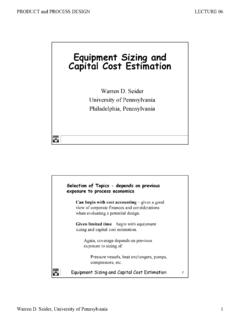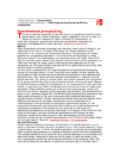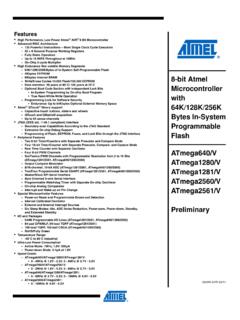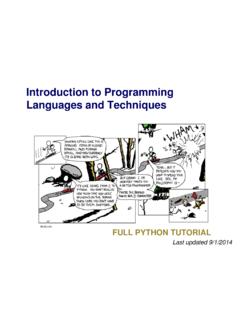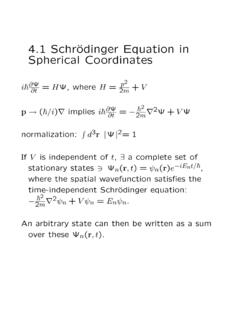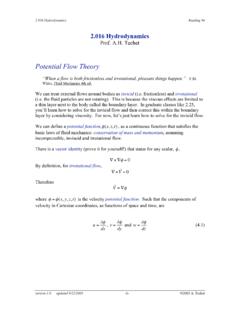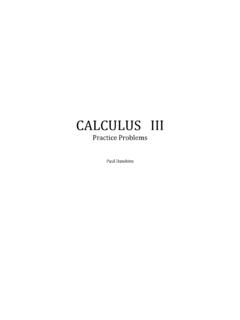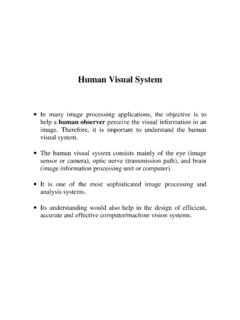Transcription of 1. Vectors, contravariant and covariant
1 GENERAL RELATIVITY IRREDUCIBLE MINIMUMALAN L. , contravariant and covariant12123e1e2e2e1 xyPFigure basis vectors in two dimensional flat space. Angle be-tween basis vectors = . Basis vectors{e1,e2}are set against a backgroundof Cartesian coordinates {x,y}. The basis set for covectors is{e1,e2}.Vectors are the simplest form of tensor. In 4-dimensional spacetime, tensors like the Riemanncurvature tensor are of order 4 with 44= 256 components. It is helpful to begin the study of tensorswith vectors, tensors of order 1 with only four components. Or simplify still further by working in2-dimensional spacetime, with two components and two basis vectors. This simple two-dimensionalcase is adequate to illustrate the curvature of space ( , the surface of a sphere), the differencebetween contravariant and covariant vectors, and the metric , terminology is confusing and inconsistent. The old-fashioned but still widely usednames used to distinguish types of vectors arecontravariantandcovariant.
2 The basis for thesenames will be explained in the next section, but at this stage it is just a name used to distinguishtwo types of vector. One is called the contravariant vector or just the vector, and the other one iscalled the covariant vector or dual vector or one-vector. A strict rule is that contravariant vector12 ALAN L. MYERS components are identified with superscripts likeV , and covariant vector components are identifiedwith subscripts likeV . The mnemonic is: Co- is low and that s all you need to know. This discussion is focused on distinguishing contravariant and covariant vectors in the flat Carte-sian space of Figure 1. A set ofbasis vectors{~e1,~e2}is chosen so that any vector~Vcan be expressedas:~V=V1~e1+V2~e2=V ~e Notice that the path for locating a point traces a parallelogram (in two dimensions) or a paral-lelepiped (in three dimensions). Components arenotdetermined by perpendicular projections ontothe basis vector as for Cartesian the usefulness of the Einstein summation rule is apparent: Any term containing adummyvariableforces a summation, in this case only overi= 1,2 but in general over the four dimensionsof spacetime.
3 The dummy variable must be paired up and down, subscript and superscript, like here. The basis vectors need be neither normalized nor orthogonal, it doesn t matter. In this case,the basis vectors{~e1,~e2}are normalized for simplicity. Given the basis set{~e1,~e2}for vectors, abasis set for dual vectors{ e1, e2}is defined by:(1) e ~e = The~symbol identifies vectors and their basis vectors, the symbol identifies dual vectors and theirbasis vectors. As shown on Figure 1, the dual basis vectors are perpendicular to all basis vectorswith a different index, and the scalar product of the dual basis vector with the basis vector of thesame index is unity. The basis set for dual vectors enables any dual vector Pto be written: P=P1 e1+P2 e2=P e The set of basis vectors and their corresponding covectors for the example in Figure 1 are:~e1= (1,0) e1= ( , )~e2= ( , ) e2= (0, )which satisfy Eq. (1):~e1 e1= 1;~e2 e2= 1;~e1 e2=~e2 e1= 0 Consider the vectorOPfrom the origin to pointPon Figure 1, which can be written in terms ofits basis vectors:OP=~V=V1~e1+V2~e2= ~e1+ ~e2or in terms of its basis set for the covectors:OP= P=P1 e1+P2 e2= 2 e1+ e2A vector may be thought of as an object that operates on a covector:~V( P) = ( ~e1+ ~e2)(2 e1+ e2) = yields the scalar product.
4 Or vice versa for P(~V).The values of these coordinates , (V1,V2) = ( , ) for the vector and (P1,P2) = ( , )for the dual vector, can be verified by geometry. The metric tensorg defined by its basis vectors:g =~e ~e The metric tensor provides the scalar product of a pair of vectors~Aand~Bby~A ~B=g V V The metric tensor for the basis vectors in Figure 1 isgij=(~e1 ~e1~e1 ~e2~e2 ~e1~e2 ~e2)=( )The inverse ofgijis the raised-indices metric tensor for the covector space:gij=( e1 e1 e1 e2 e2 e1 e2 e2)=( )GENERAL RELATIVITY IRREDUCIBLE MINIMUM3 The metric tensor for contravariant - covariant components is:gij=( e1 ~e1 e1 ~e2 e2 ~e1 e2 ~e2)=(1 00 1)The square of the vector~Amay be calculated from the metric in several ways:~V ~V=gijAiAj=g11V1V1+g12V1V2+g21V2V1+g22V2 V2= P P=gijPiPj=g11P1P1+g12P1P2+g21P2P1+g22P2P 2= P ~V=gijPiVj= ijPiVj=PiVi=P1V1+P2V2= components may be calculated from countervariant components using the metricPj=gijViand countervariant components may be calculated from one-forms using the inverse metricVj=gijPiFor example.
5 P1=g11V1+g21V2= (1)( ) + ( )( ) = +g22V2= ( )( ) + (1)( ) = of vectors.(2)V = x x V For spacetime, the derivative represents a four-by-four matrix of partial derivatives. A velocityVinone system of coordinates may be transformed intoV in a new system of coordinates . The upperindex is the row and the lower index is the column, so for contravariant transformations, is therow and is the column of the example, for a 4-velocity vector in spacetime:V = x = x x x = x x V where is the proper :(r, ) (x,y).x=rcos y=rsin x x =( x 1 x1 x 1 x2 x 2 x1 x 2 x2)=( x r x y r y )=(cos rsin sin rcos ) :(x,y) (r, ). The relations arer= x2+y2 = arctan(yx) x x =( x 1 x1 x 1 x2 x 2 x1 x 2 x2)=( r x r y x y)=(x x2+y2y x2+y2 yx2+y2xx2+y2)=(cos sin sin rcos r)The transformation matrices are L. (3)V = x x V The rule is that the upper index refers to the row and the lower index to the column, so for one-formtransformations is the row and is the column. For example, a gradientVin one system ofcoordinates is transformed into aV gradient in a new system of coordinates .
6 The chain rule for apotential is:V = x = x x x =V x x StrictlyV in this equation should be a row vector, but the order of matrices is generally ignored asin Eq. (3). rules for transformation of tensors of arbitrary rank are ageneralization of the rules for vector transformation. For example, for a tensor of contravariant rank2 and covariant rank 1:T = x x x x x x T where the prime symbol identifies the new coordinates and the transformed metric tensor defined by:(4)g =e e Infinitesimal displacement vector:d~x=dx e dx2= (dx e ) (dx e ) =g dx dx More generally for vectors~Vand~W:~V ~W=g V W This is the new inner product, invariant under any linear transformation. It reproduces the old inner product in an orthonormal basis:A B= (1 A1B1) + (1 A2B2) + (1 A3B3) contracted to a scalar (S) by multiplication with a one-formA :A B =SContraction of indices for a tensor works as follows:T = x x x x x x T = x x x x T = x x T = x x T Contracted tensorsT andTtransform as contravariant vectorsV andV:V = x x V Of fundamental importance is the use of the metric tensorg and its inverse (dual metric)g toraise and lower indices:T =g T T =g T This process works for higher order tensors:Ajk=gijAikCijk=gjmCimkTijk=gimTj kmGENERAL RELATIVITY IRREDUCIBLE MINIMUM5 The Kronecker delta may be written as a tensor in terms of the metric and its inverse:g g = The double contraction of a symmetric tensorS and an asymmetric tensorA is zero, that isA S = and Lowering Indices in E& electric field can refer to a gradient:E= V= E = V x or to a force:E=Fq= E =F q=ma qThe index can be raised or lowered using the metric.
7 E =g E E =g E In an orthonormal system, it makes no Symbols from Metric TensorDefinition of Christoffel symbol is kijek= ei xjThe symbol by itself is not a tensor. Form dot product: kijek em=em ei xj kij mk=em ei xj mij=em ei xjLet ei xj= ej xi. This equality is for basis vectors and does not hold for unit vectors, for example, in spherical corrdinates r 6= r. The Christoffel symbol is symmetric in its two lower indices: kij= kji. mij=12em ei xj+12em ej xi mij=12em ei xj+(12gkm ek xj ei 12gkm ej xk ei)+12em ej xi+(12gkm ek xi ej 12gkm ei xk ej)The terms on each line inside the parentheses sum to zero. Usingem=gkmek: mij=12gkmek ei xj+(12gkm ek xj ei 12gkm ej xk ei)+12gkmek ej xi+(12gkm ek xi ej 12gkm ei xk ej) mij=12gkm[(ek ei xj+ ek xj ei)+(ek ej xi+ ek xi ej) (ei ej xk+ ei xk ej)] mij=12gkm[ (ek ei) xj+ (ej ek) xi (ei ej) xk](5) mij=12gkm[ gik xj+ gjk xi gij xk]6 ALAN L. for metric for a sphere is:ds2=dr2+r2d 2+r2sin2 d 2 For a 2-sphere of radiusR:ds2=R2d 2+R2sin2 d 2 For a unit 2-sphere:gij=(g g g g )=(100 sin2 )gij=(g g g g )=(1001sin2 )There are 8 Christoffel symbols and only 3 of them are non-zero: = =12g g x =12(1sin2 )(2 sin cos ) = cot = 12g g x = 12(1)(2 sin cos ) = sin cos Eq.
8 (5) contains 6 terms of typegij gij xkfor each of the 8 symbols, a total of 48 VersionConsider in this section only non-curved coordinates on a flat manifold. The gradient of a scalarfield is: f= f x = fThe gradient of a vector field is: V= V x = V and its divergence is: V= V x = V The vector product ofAandBis:C=A B= ci= ijkajbkwhere is the permutation symbol (or alternating unit tensor) sometimes called the Levi-Civitapseudo-tensor, which is completely anti-symmetric. 123= 1 and so does any even permutation of123 like 231; 132= 1 and so does any odd permutation of 123 like 132; and = 0 if two of thethree indices have the same value. Or imagine a clock with 1 at 12 o clock, 2 at 4 o clock and 3 at8 o clock. = +1 for clockwise permutations and = 1 for counter-clockwise permutations. Forexample, for the vector product:c1= 1jkajbk= 123a2b3+ 132a3b2=a2b3 a3b2 The following identify is useful:eijkei`m= j` km jm k`The scalar product isa b=aibiGENERAL RELATIVITY IRREDUCIBLE DerivativeWe will need the connection coefficient: kijek= ei xjFor an abstract vectorVexpanded in countervariant basis vectors:V=Viei V xj= Vi xjei+Vi ei xj= Vi xjei+Vi kijek= Vi xjei+Vk ikjei=( Vi xj+Vk ikj)eiIn terms of its coefficient tensor, the covariant derivative of a vector is jVi= Vi xj+Vk ikjFor an abstract vectorVexpanded in covariant basis vectors:V=Viei V xj= Vi xjei+Vi ei xj= Vi xjei+Vk ek xjA connection coefficient is needed for the derivative of a covariant base vector.
9 Starting with:eiek= ki ei xjek+ ek xjei= 0 = mijemek+ ek xjei= 0 = ei ek xj= kijMultiplying byeieiei ek xj= ek xj= ei kijSubstitution yields V xj= Vi xjei Vk kijei=( Vi xj Vk kij)eiThe covariant derivative of a one-form is jVi= Vi xj Vk kijNote the positive sign for vectors and the minus sign for to Higher-Order Tensors. kTij= Tij xk+Tmj imk+Tim jmk kTij= Tij xk Tmj mik Tim mjk kTij= Tij xk+Tmj imk Tim mjk8 ALAN L. Curvature TensorParallel transport of a vector is defined as transport for which the covariant derivative is Riemann tensor is determined by parallel transport of a vector around a closed loop. Considerthe commutator of covariant differentiation of a one-vector:[ ]V In a flat space, the order of differentiation makes no difference and the commutator is zero so thatany non-zero result can be attributed to the curvature of the space. V = V x V V V = V x V V V = V x V V = 2V x x x V V x ( V x V ) ( V x V ) V = V x V V = 2V x x x V V x ( V x V ) ( V x V )Each equation has 7 terms.
10 In the commutator, the first terms cancel because the order of normalpartial derivatives does not matter. The 3rd term of the first equation cancels with the 4th term ofthe second equation because the symbols used for dummy indices are irrelevant. The 4th term ofthe first equation cancels with the 3rd term of the second equation for the same reason. The 6thand 7th terms cancel because Christoffel symbols are symmetric in their lower indices. Only the 2ndand 5th terms survive:[ ]V =( x x + )V The terms within the parentheses define the Riemann curvature tensor:R x x + A necessary and sufficient condition for flat space is that the Riemann curvature is equal to TensorThe first and fourth indices are contracted to give:R =R = x x + For spacetime coordinates :R = x x + Some authors contract the first and third indices. Because of symmetries, other contractions giveeither zero or R.
